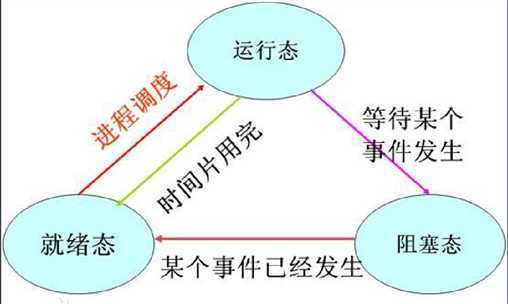广义定义:进程(Process)是计算机中的程序关于某数据集合上的一次运行活动,是系统进行资源分配和调度的基本单位。
狭义定义:进程是正在运行的程序的实例(an instance of a computer program that is being executed)。
在操作系统中引入进程的概念,是为了实现多个程序的并发执行。

Linux操作系统:
import os print(‘Process (%s) start...‘ % os.getpid()) # Only works on Unix/Linux/Mac: pid = os.fork() #创建一个子进程 if pid == 0: print(‘I am child process (%s) and my parent is %s.‘ % (os.getpid(), os.getppid())) else: print(‘I (%s) just created a child process (%s).‘ % (os.getpid(), pid))
import os import time cnt = 100 print(‘Process (%s) (%s) start...‘ % (os.getpid(), os.getppid())) # Only works on Unix/Linux/Mac: pid = os.fork() #创建一个子进程 if pid == 0: time.sleep(3) print(cnt, ‘I am child process (%s) and my parent is %s.‘ % (os.getpid(),os.getppid())) else: cnt = 1000 print(cnt, ‘I (%s) just created a child process (%s).‘ % (os.getpid(), pid)) #os.wait() while True: pass
fork() 调用一次返回两次
在父进程中返回大于0的值pid,pid:子进程的pid(进程id)
在子进程中返回0
os.getpid(): 获取当前进程的pid
os.getppid(): 获取父进程的pid
windows操作系统:
from multiprocessing import Process import os # 子进程要执行的代码 def run_proc(name): print(‘Run child process %s (%s)...‘ % (name, os.getpid())) if __name__==‘__main__‘: print(‘Parent process %s.‘ % os.getpid()) p = Process(target=run_proc, args=(‘test‘,)) print(‘Child process will start.‘) p.start() p.join() print(‘Child process end.‘)
import os import time # 子进程要执行的代码 def run_proc(*args): print(args[0], args[1]) if __name__==‘__main__‘: p = Process(target=run_proc, args=(‘test1‘,"test2")) p.start() p.join() #阻塞等待子进程退出,并且回收子进程的资源 print(‘Child process end.‘)
from multiprocessing import Pool import os, time, random def worker(msg): t_start = time.time() print("%s开始执行,进程号为%d" % (msg,os.getpid())) # random.random()随机生成0~1之间的浮点数 time.sleep(random.random()*2) t_stop = time.time() print(msg,"执行完毕,耗时%0.2f" % (t_stop-t_start)) if __name__ == "__main__": po = Pool(5) # 定义一个进程池,最大进程数5 for i in range(0,10): po.apply_async(worker,(i,)) # Pool().apply_async(要调用的目标,(传递给目标的参数元祖,)) for i in range(100,110): po.apply_async(worker,(i,)) # Pool().apply_async(要调用的目标,(传递给目标的参数元祖,)) print("----start----") po.close() # 关闭进程池,关闭后po不再接收新的请求 po.join() # 等待po中所有子进程执行完成,再执行下面的代码,可以设置超时时间join(timeout=) print("-----end-----")
子进程是父进程的拷贝。
父子进程拥有自己独立的地址空间。
孤儿进程:如果一个进程的父进程先于他自己退出,那么这个进程就叫做孤儿进程。
僵尸进程:Linux中一个进程‘退出‘以后其实并没有真正退出,而是系统将其状态标记为“zombie”状态,如果该进程的父进程没有回收子进程的系统资源,则该进程就叫僵尸进程。危害:浪费系统资源。
如何防止僵尸进程?
一般,为了防止产生僵尸进程,在fork子进程之后我们都要wait它们;同时,当子进程退出的时候,内核都会给父进程一个SIGCHLD信号,所以我们可以建立一个捕获SIGCHLD信号的信号处理函数,在函数体中调用wait(或waitpid),就可以清理退出的子进程以达到防止僵尸进程的目的。
线程:进程内部的执行分支, 是系统进行任务调度的最小单元。
线程的查看:
ps -eLf
PID PPID LWP C NLWP CMD
进程ID 父进程ID
LWP:light weight process 轻量级进程 => 线程
import time, threading #线程函数 def loop(): print(‘thread %s is running...‘ % threading.current_thread().name) #打印当前运行的线程的名称 print(‘thread %s is running...‘ % threading.current_thread().name) t = threading.Thread(target=loop, name=‘LoopThread‘) t.start() #启动线程 t.join() #阻塞等待子线程退出 print(‘thread %s ended.‘ % threading.current_thread().name)
互斥锁/互斥量 mutex
A、创建锁 mutex = threading.Lock()
B、加锁 mutex.acquire()
C、解锁 mutex.release()
import time, threading cnt = 0 #构造一个互斥锁 mutex = threading.Lock() #子线程 线程函数 def loop(): global cnt #mutex.acquire() for i in range(1000000): #加锁 mutex.acquire() cnt += 1 #解锁 mutex.release() #mutex.release() print(threading.current_thread().name, ": ", cnt) print(‘thread %s is running...‘ % threading.current_thread().name) #主线程 #打印当前运行的线程的名称 print(‘thread %s is running...‘ % threading.current_thread().name) t = threading.Thread(target=loop, name=‘LoopThread‘) t.start() #启动线程 t1 = threading.Thread(target=loop, name=‘LoopThread1‘) t1.start() #启动线程 t2 = threading.Thread(target=loop, name=‘LoopThread2‘) t2.start() #启动线程 t.join() #阻塞等待子线程退出 t1.join() #阻塞等待子线程退出 t2.join() print("MainThread: ", cnt) print(‘thread %s ended.‘ % threading.current_thread().name)
import time, threading cnt = 100 #子线程 线程函数 def loop(): global cnt cnt = 1000 print(threading.current_thread().name, ": ", cnt) print(‘thread %s is running...‘ % threading.current_thread().name) def loop1(): global cnt print(threading.current_thread().name, ": ", cnt) cnt = 2000 print(threading.current_thread().name, ": ", cnt) print(‘thread %s is running...‘ % threading.current_thread().name) #主线程 #打印当前运行的线程的名称 print(‘thread %s is running...‘ % threading.current_thread().name) t = threading.Thread(target=loop, name=‘LoopThread‘) t.start() #启动线程 t1 = threading.Thread(target=loop1, name=‘LoopThread1‘) t1.start() #启动线程 t.join() #阻塞等待子线程退出 t1.join() #阻塞等待子线程退出 print("MainThread: ", cnt)
原文:https://www.cnblogs.com/-Leif/p/12950851.html